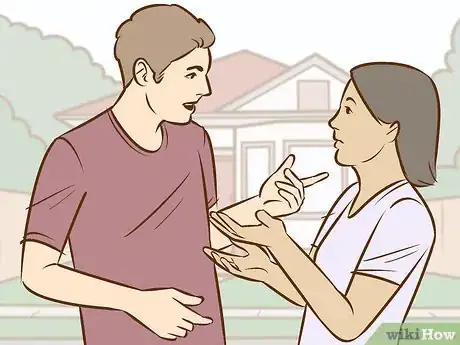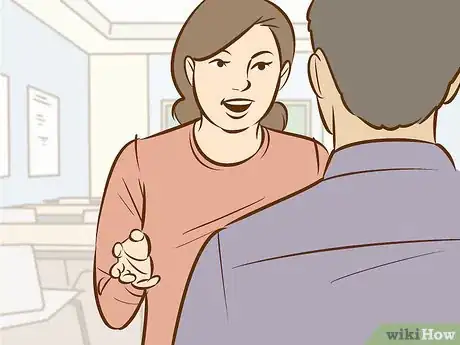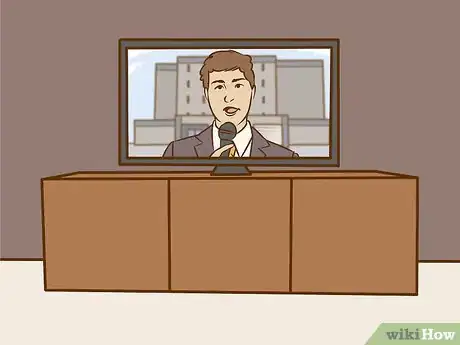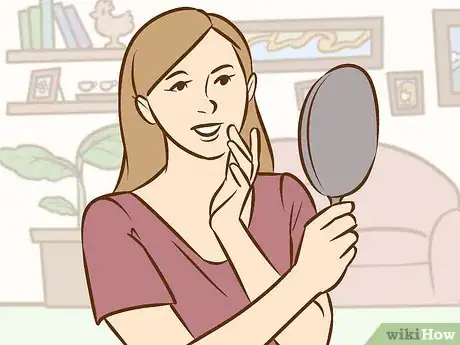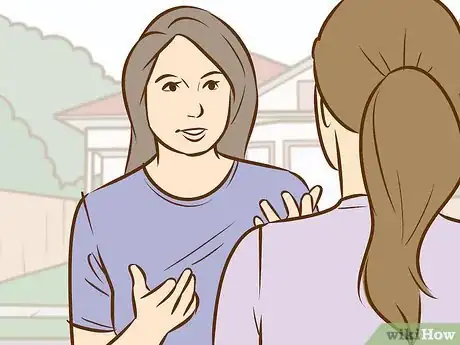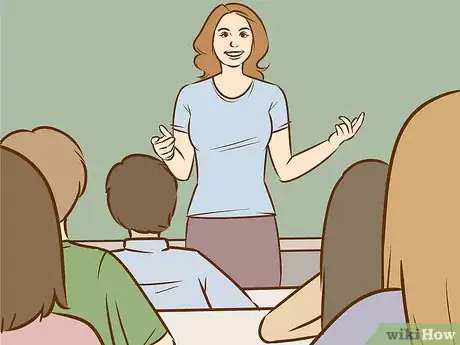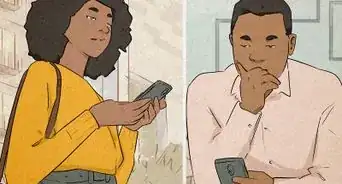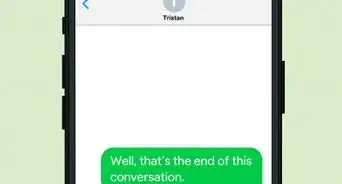This article was co-authored by wikiHow Staff. Our trained team of editors and researchers validate articles for accuracy and comprehensiveness. wikiHow's Content Management Team carefully monitors the work from our editorial staff to ensure that each article is backed by trusted research and meets our high quality standards.
There are 10 references cited in this article, which can be found at the bottom of the page.
wikiHow marks an article as reader-approved once it receives enough positive feedback. This article received 18 testimonials and 83% of readers who voted found it helpful, earning it our reader-approved status.
This article has been viewed 431,263 times.
Learn more...
Reading lips is a special talent that takes patience and time to master. But everyone, even those with perfect hearing, already lip reads on occasion. While it is impossible to read lips completely since English has several identical looking sounds, a little bit of practice and awareness can help you pick up most of what people are saying without hearing a thing.
Steps
Understanding How to Lip Read
-
1Know that you must focus equally on context and visual cues as the actual lips. Only 30-40% of sounds in the English language are noticeable by sight. Too many of our words and syllables are so similar that you can't actually just tell them by lip reading alone. Most lip-readers will tell you, at the end of the day, that lip-reading isn't actually reading. The words aren't so simple, and tics, mumbling, accents, and mouth covering all make straight "reading" impossible. Once you learn to make lipreading a part of your communication, not the only tool you have, you will be much more successful.
- At Better Hearing Australia's annual lip reading competition, most people score only 40-50%. The few who hit 90% and higher do so through context, context, and guess work.
-
2Lipread sentences, not single words. Trying to pick up every single word is going to be hard, and you'll struggle mightily. Most lip-readers know that long words and sentences are easier to read than short ones because longer phrases allow you to fill in the blanks through context. By focusing on the whole sentence, you can comfortably miss a few words here and there and still understand what was actually said.[1]Advertisement
-
3Check in to facial movements and expressions to understand tone and mood. The eyes and mouth are incredibly expressive -- often more so than your tone of voice. Don't just look at someone's lips, as the rest of their face offers important contextual clues to determine not only the sentence but how the sentence is said.[2]
- Tugging at the lips (small grimaces or smiles) often indicate worry, fear, or anxiety.
- Raised eye brows also tend to indicate anxiety or stress.
- Furrowed brows and foreheads indicate displeasure or anger.
- Creases around the edges of the eyes indicate happiness and excitement.
- Cocking the head to the side usually indicates discomfort or even slight hostility. Looking down shows nervousness, shyness, or an unwillingness to communicate.[3]
-
4Study body-language and posturing to learn from non-verbal cues. You're trying to translate one sense (sound) into another (sight), and this is an inherently impossible task to perfect. The best lip readers use everything to their advantage, including body language, to gauge mood, tone, and themes of conversation. While imperfect, this list covers many of the basics:[4]
- Closed off arms tend to indicate anger or aggression. Open arms indicate friendship, closeness, and honestly. Open and closed legs have similar connotations.
- The way a person's shoulders and hips point often indicate their priorities or who they are most comfortable with.
- Leaning towards you implies intimacy and connection. Leaning away generally indicates discomfort or confusion.
- Big, expansive posture implies confidence, strength, and dominance. Slouching shows a lack of confidence .
- There is a lot of nuance, subtlety, and interpretation involved in body language, and every situation is different. But, used with lip reading, you can learn a lot very quickly in most situations.[5]
-
5Know which syllables look similar to avoid common mistakes. There are 44 different sounds formed in English. Unfortunately, only a third of them are visually different.The following list of sounds can get tricky, as they have similar mouth shapes when formed, or are frequently confused. Even more confusing is that the brackets indicate the letters sound, not the letters themselves:
- [b] & [p]
- [k] & [g],
- [t] & [d],
- [f], [v], & [th]
- [s] & [zzzz]
- [m] & [n][6]
-
6Use the words you do know to figure out the ones you don't. You're basically given an incomplete map and asked to fill in the blanks, and you're not always going to get it right. But this is far more effective then harping on every word and sound. Many lip readers know they need to take a second to "re-construct" the sentence before responding, allowing them to speak more fluidly and skip over issues.[7] [8]
-
7Ask people to speak a little bit slower if you're comfortable. Just be honest with your conversation partner and ask them to slow it down a bit. The point of a chat isn't to impress someone with your skills, but to actually talk to someone! Slower, better enunciated words will be much easier to read and pull context from.
Practicing Lip Reading
-
1Watch TV and focus on how people's lips move when they talk. Start with the news, as you'll have clear speakers who are looking right at the camera every single time. If you have partial hearing, turn the volume up and listen along -- you'll be able to attach the "sounds" to the lip motions. If you are completely deaf, turn the closed captions on and use them to guide your lip reading.
-
2Stare at yourself in the mirror, say the alphabet, talk out song lyrics, recite something. The whole time focusing on what your lips look like when they make different sounds/words. Slow down and try out tricky syllables or related sounds (like p, b, and m) to get used to the combination of word and visual. By saying the words out loud as you read, you help internalize the syllable for future lip reading.[9]
-
3Ask your friends to help you practice by talking clearly, slowly, and head on. Unfortunately, most conversations don't take place in a television studio. To improve your daily lipreading skills, start with your friends. Let them know you're working on lipreading, and that they can help by speaking clearly, slowly, and looking straight at you. As you get better, ask them to speed up to normal conversational pace.[10]
-
4Consider taking a lipreading class. Offered in most cities and towns, these are casual, supportive communities to practice in. Frequently you'll work together on difficult syllables and tricks, then break into conversation groups to get some practice in. Look online for lipreading classes to grow and develop your skills.[11]
-
5Be confident in your skills and push yourself to have conversations. The best way how to learn to lipread in public is to start lipreading in public. You may feel nervous, but just remember that very, very few people are going to get angry, upset, or otherwise negative when they find out you're lip reading. Communication is a two-way street -- and people will be willing and happy to help you learn and repeat sentences you've missed.
Community Q&A
-
QuestionIs there any point in learning lip reading?
 Community AnswerMany Deaf people use lip reading to help communicate with people who do not speak sign language. People who are not Deaf may just find it interesting to learn.
Community AnswerMany Deaf people use lip reading to help communicate with people who do not speak sign language. People who are not Deaf may just find it interesting to learn. -
QuestionHow can I learn to lip read if I can hear?
 Community AnswerTry putting on a movie you have seen multiple times and watch it on mute. Study the character's lips, and use subtitles if needed. You can also buy ear plugs or wear headphones with loud classical music to block out sound instead.
Community AnswerTry putting on a movie you have seen multiple times and watch it on mute. Study the character's lips, and use subtitles if needed. You can also buy ear plugs or wear headphones with loud classical music to block out sound instead. -
QuestionIs lip reading impossible?
 Community AnswerNo, but it can be very challenging for some people. Don’t give up, it can take lots of time.
Community AnswerNo, but it can be very challenging for some people. Don’t give up, it can take lots of time.
Warnings
- This is an imperfect art -- know that it is incredibly difficult to understand every word lip reading. It is best used to supplement other methods of hearing and communication aid.⧼thumbs_response⧽
References
- ↑ https://www.lipreading.org/beginners-guide-to-lipreading
- ↑ https://www.apa.org/science/about/psa/2011/05/facial-expressions
- ↑ https://www.psychologytoday.com/blog/fulfillment-any-age/201206/the-ultimate-guide-body-language
- ↑ https://www.helpguide.org/articles/relationships-communication/nonverbal-communication.htm
- ↑ https://www.psychologytoday.com/blog/fulfillment-any-age/201206/the-ultimate-guide-body-language
- ↑ Benguerel AP, Pichora-Fuller MK. 1982 Coarticulation effects in lipreading.J. Speech Hear Res. 1982 Dec;25(4):600-7.PMID 7162162
- ↑ http://www.bloomberg.com/news/articles/2013-04-11/how-to-read-lips-by-professional-lip-reader-larry-wenig
- ↑ http://www.theatlantic.com/video/index/420516/can-you-read-my-lips/
- ↑ https://rnid.org.uk/wp-content/uploads/2020/05/Learning-to-lipread-leaflet.pdf
About This Article
If you want to read lips, start by using a mirror to watch yourself say the alphabet or recite something, so you can see what your lips look like when you make different sounds and words. You can also watch news anchors on TV to try and attach sounds to lip motions, since you can see their mouths clearly as they look directly into the camera. When you’re ready to start lipreading, work on picking up key words rather than every word, which is difficult. Then, you can use context and visual cues to fill in gaps, and facial expressions and body language to pick up tone and mood. For more tips on how to read people’s faces and bodies to help you read lips, read on!



